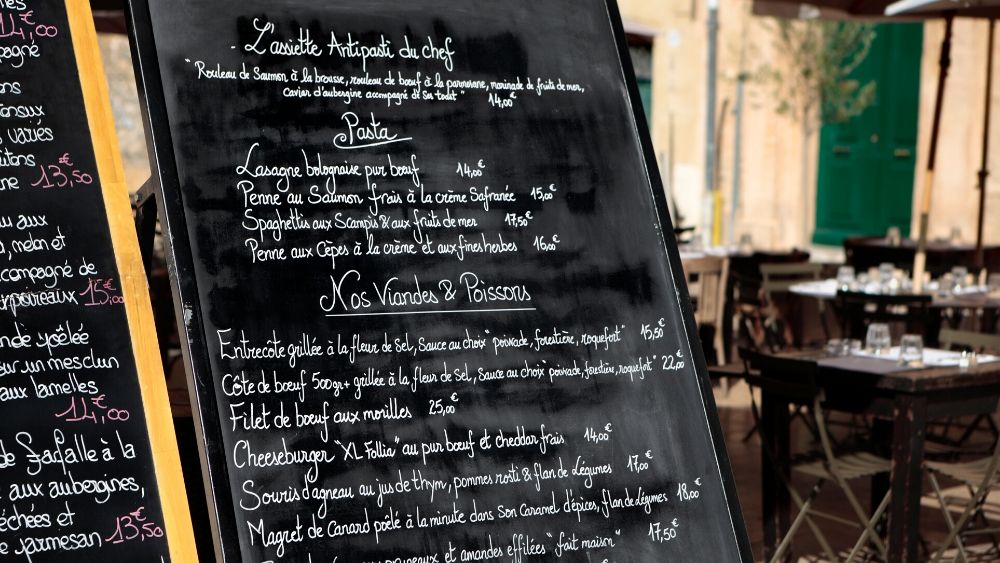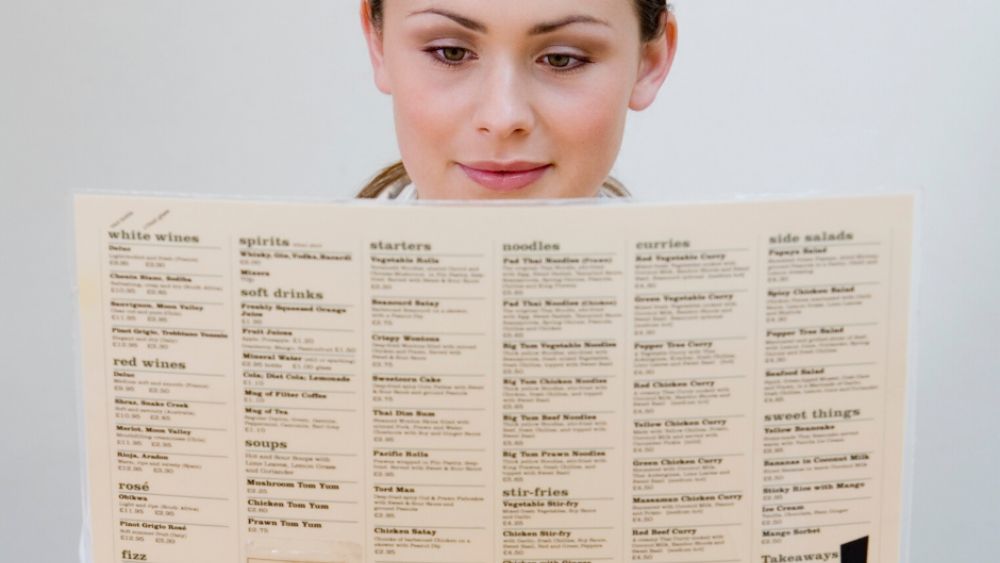
The next time you look at a menu at your local restaurant and are impressed, there is more that goes into it than you think. Restaurants looking to engage and excite customers while increasing profitability are turning to menu engineering.
Menu engineering transforms a menu from just stating what is served to the science of word choice, visual presentation, and more – all to enhance the customer experience. Menu Engineering became popular in the 1970’s and is still used around the world today. According to kitchencut.com, Menu Engineering is defined as “maximizing a business’s profitability by subconsciously encouraging customers to buy what you want them to buy, specifically the higher profit dishes on your menu and the ones that have the best Margin %.”
The primary objective of Menu Engineering is to design a menu that will attract customers and drive sales. Menu Placement, Menu Wording, Dish Descriptions, and Size of the Wording and Font are key elements in Menu Engineering. Research has shown that strategies to enhance these categories increase profitability, sales, and customer experience. This article will review these factors and how they can increase your sales when using these strategies.
Menu Engineering: Placement
Menu Placement focuses on the location of menu items to attract the greatest attention to specific dishes. Why is this important? Whether to move specific foods or to increase profitability, menu placement has a tremendous influence on customers. When creating a menu, restaurateurs consider how, and where to put their most profitable items. There are numerous attention-grabbing techniques that will influence selection.
On average, customers spend 109 seconds reading a menu. To put this in perspective, people spend more time taking out the garbage than looking at a restaurant’s menu. Every second count for restaurants. Literally. By grabbing the reader’s attention through photos, clip art enhanced color when presenting a dish, the reader’s focus can be influenced, driving profitability.
Menu Engineering: Wording
When customers read a menu, the use of adjectives and certain trigger descriptive words can greatly influence one’s menu selection. The goal is to paint a picture in one’s mind so they can close their eyes and almost imagine the taste of an item, just by its descriptive words. The wording of a menu can reflect the unique style of a restaurant and can offer a way to stand out. Think about it: Would you want to order something that has the description “Ground Beef”? Or would you want to order a dish that has the words, “Savory”, “Juicy”, and “Delicious”? These words are sensory words.
Sensory words provide a way for the customer to imagine what the dish looks like before ordering it. In fact, GrubHub, found that 27 Percent of Sales were increased because of Sensory Words. It also improved the diner’s perception of the overall quality of the restaurant. This proves that menu wording can increase profitability and sales. When people imagine the meal before ordering it, it will make the experience of eating the food even better.
Menu Engineering: Dish Descriptions
Dish Descriptions are another technique of menu engineering that can influence customer selection. The key factor is brevity. The average attention span of people is eight seconds according to cision.com. This is another example of how every second count in menu engineering. Customers need to read a menu and feel the emotions of wanting to eat and order more dishes. Dish Descriptions offer a unique way of standing out from other dishes.
When a reader reads about how a steak is “marinated”, with the finest ingredients, then grilled to perfection, dish descriptors have the power to entice them to order that steak. And when multiple descriptions have sensory words, customers will want to come back to try the other dishes that they were not able to when they initially came. Additionally, the way a restaurant describes its menu is a great way to differentiate themselves from competitors. Think smoky, zesty, earthy, fresh, rich, robust, and tangy next time you create your menu.
Menu Engineering: Size of the Wording and Font
The use of increasing size and font on a menu is another way for restaurants to grab a customer’s attention. Some of the most popular dishes are the ones that restaurants want the customer to order. According to psychologists, placing the most prominent menu dishes in the center, the top right, and the top left of the page is the “Golden Triangle”. This is where our eyes tend to go first when looking at a menu. The Golden Triangle is an example of “Menu Psychology.” Restaurants use this strategy because when they see that a specific dish is their most selling one,

Menu Psychology and How it is Different than Menu Engineering
This is strategically creating a menu to get the reader to view your highest selling dish. Similar to Menu Engineering, Menu Psychology is based on the senses, and many restaurants create their menus based on how the senses are going to react.
According to aaronallen.com, one of the most common strategies used when developing a menu is the use of color. There are several different colors that have a goal of bringing a different emotion out. For example, the color green signifies that the food is fresh. What restaurants then do is change the font to that color. Orange stimulates the appetite. It is effective to spread these colors throughout the menu. The use of color will ignite these emotions when customers are deciding what to order. These colors will engage their senses and only make them hungrier. You can check out an article dedicated to Menu Design here: (Insert Link)
Menu Engineering: Case Study Analysis
I recently sat down with 911 Chef Eric’s founder and President, Eric Arrouzé to discuss what goes into developing an effective Menu. He then discussed one particular restaurant in which they served over 95 items on their menu. Furthermore, there were additional options to the items on the menu, they had up to 150 items. He then worked with the restaurant to perfectly optimize the dish and identified what dishes were working and what dishes could be removed. He first checked the inventory of the restaurant. The inventory that had items that were out of date from months, to even a year old.
Chef Eric analyzed the situation. He told the restaurant owners that because they weren’t selling enough food, their inventory was very full and outdated. The first thing Chef Eric did was he redid the inventory. Chef Eric and the restaurant’s team discarded any items outdated, or not in good standards. They researched and decided their primary demographics. Once they found their demographics, they then reconfigured their menu to reach their specific target market to increase sales. The process Chef Eric said, can take anywhere from days to weeks.

COVID And Final Thoughts
Additionally, as restaurants are adjusting to the new COVID world, Chef Eric mentioned that many clients and restaurants are shrinking their menu sizes. Since many restaurants are decreasing the number of people that are dining inside, they are decreasing the size of their menus. This process adjusts to the new COVID world, and also maintains safety precautions. Many restaurants are developing their business into a contactless enterprise. Developing their menus for people who do not want to eat in the restaurant for safety reasons, is an example of how Menu Engineering is a process that should be used constantly.
Chef Eric also said that Menu Engineering is beneficial for any restaurant that is trying to improve sales. Menu Engineering is also a tool that shows what recipes and strategies are working for the restaurant, and what parts about the menu can change. Many restaurants can benefit from Menu Engineering. He also said that Menu Engineering should be a process in which you review daily. It is important to understand where your food costs are going, and if there is a cost that is not benefiting your business, then changes can be made.
It is a subject overlooked by many schools and universities. However, some of the most successful establishments practice Menu Engineering every day. The next time you look at a menu at your local restaurant and think about how well the menu looks, there was most likely a strategy that was devised to entice you, the customer.
Book a free 30-minute consultation. To learn more, visit my restaurant consulting or restaurant coaching services pages. To acquire new skills, visit our Online Culinary School and start making change.